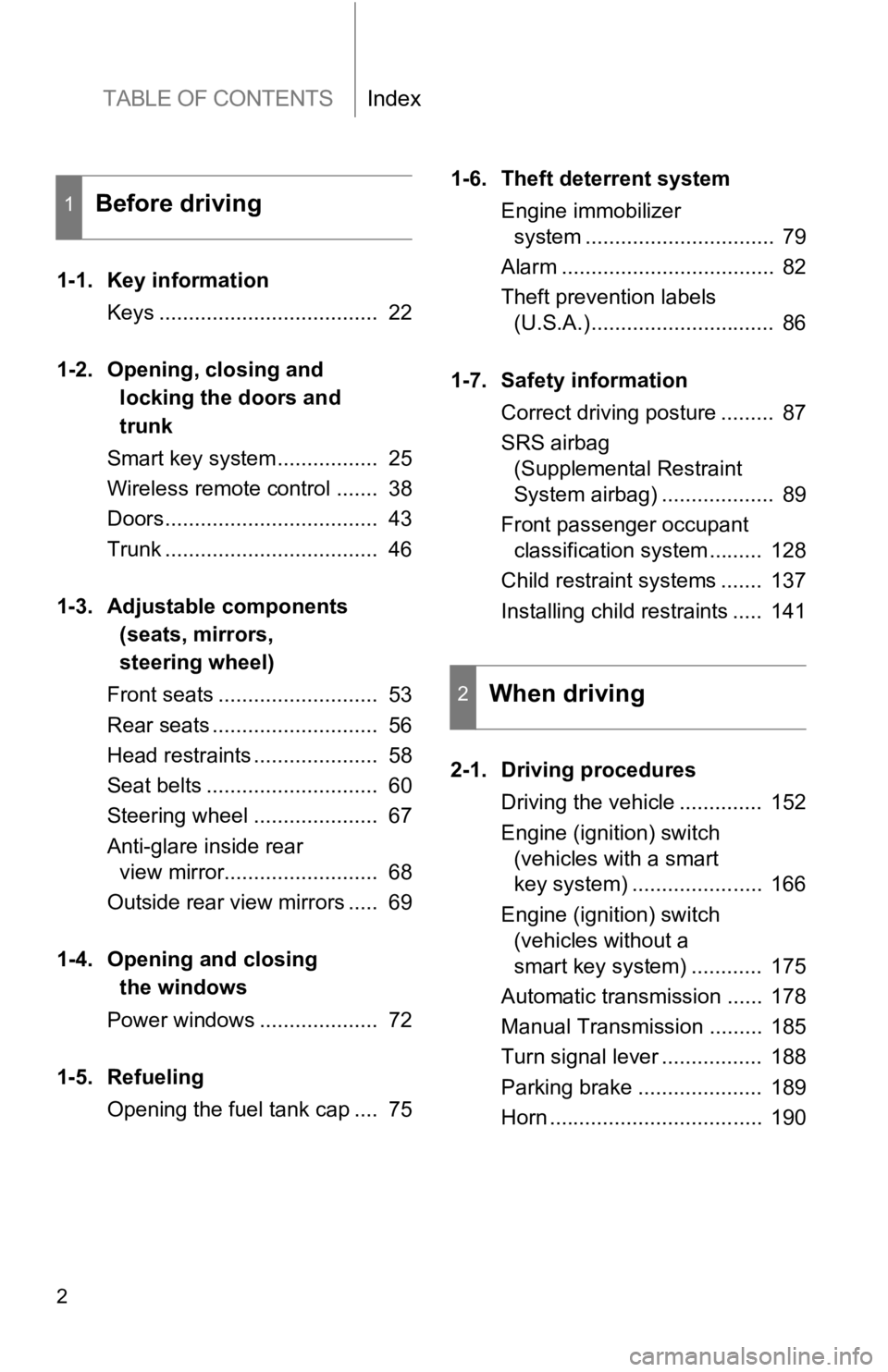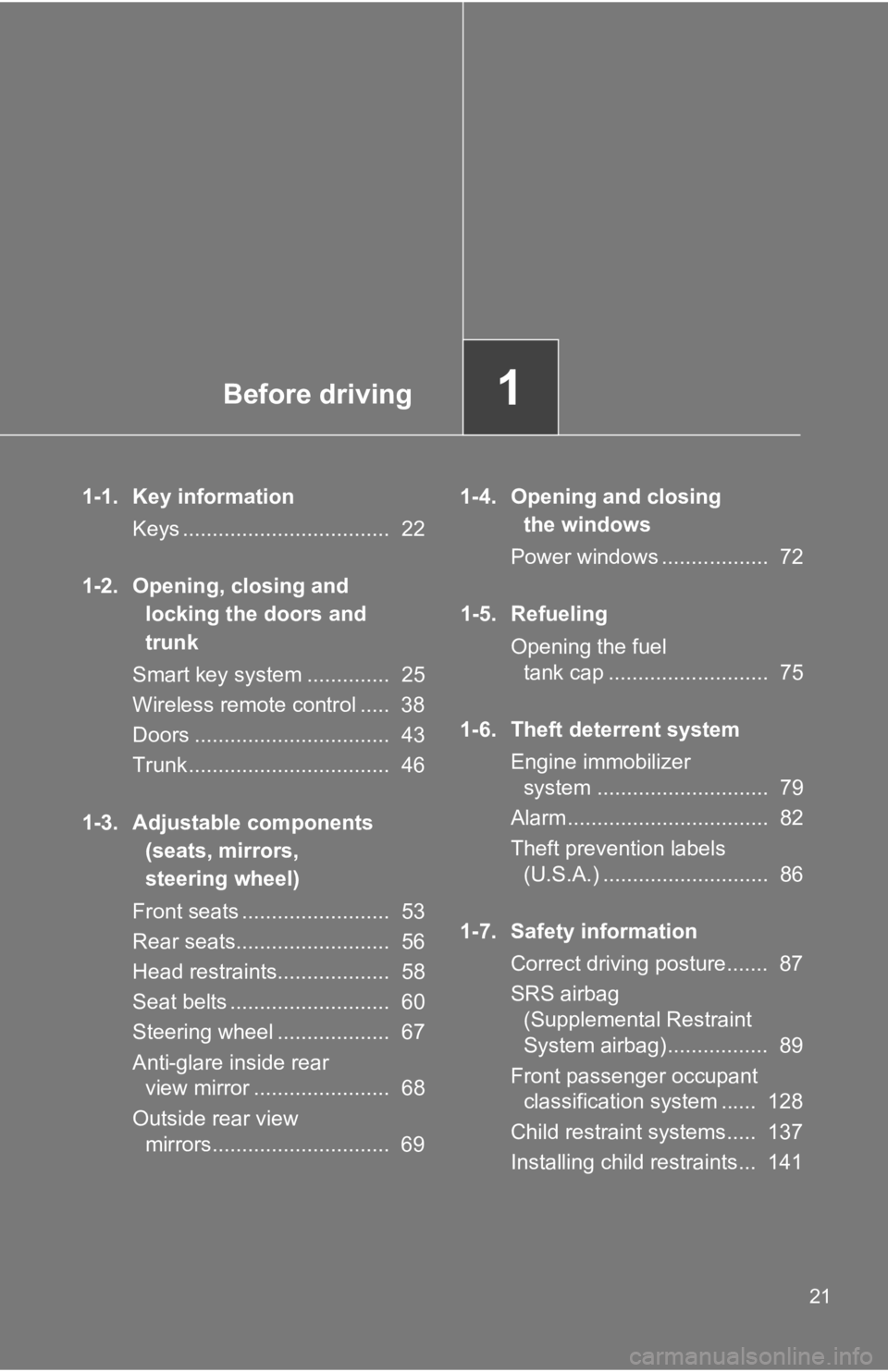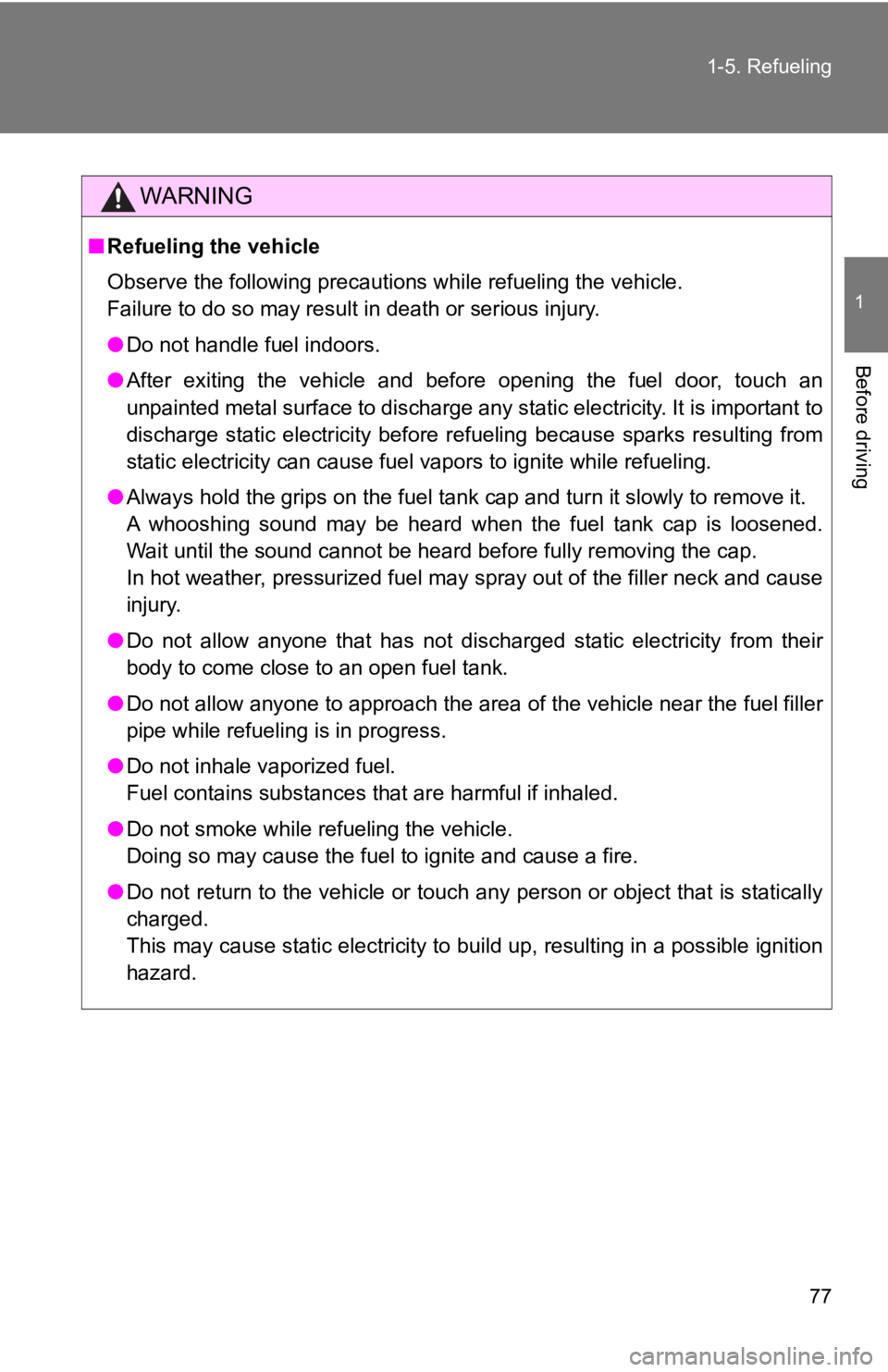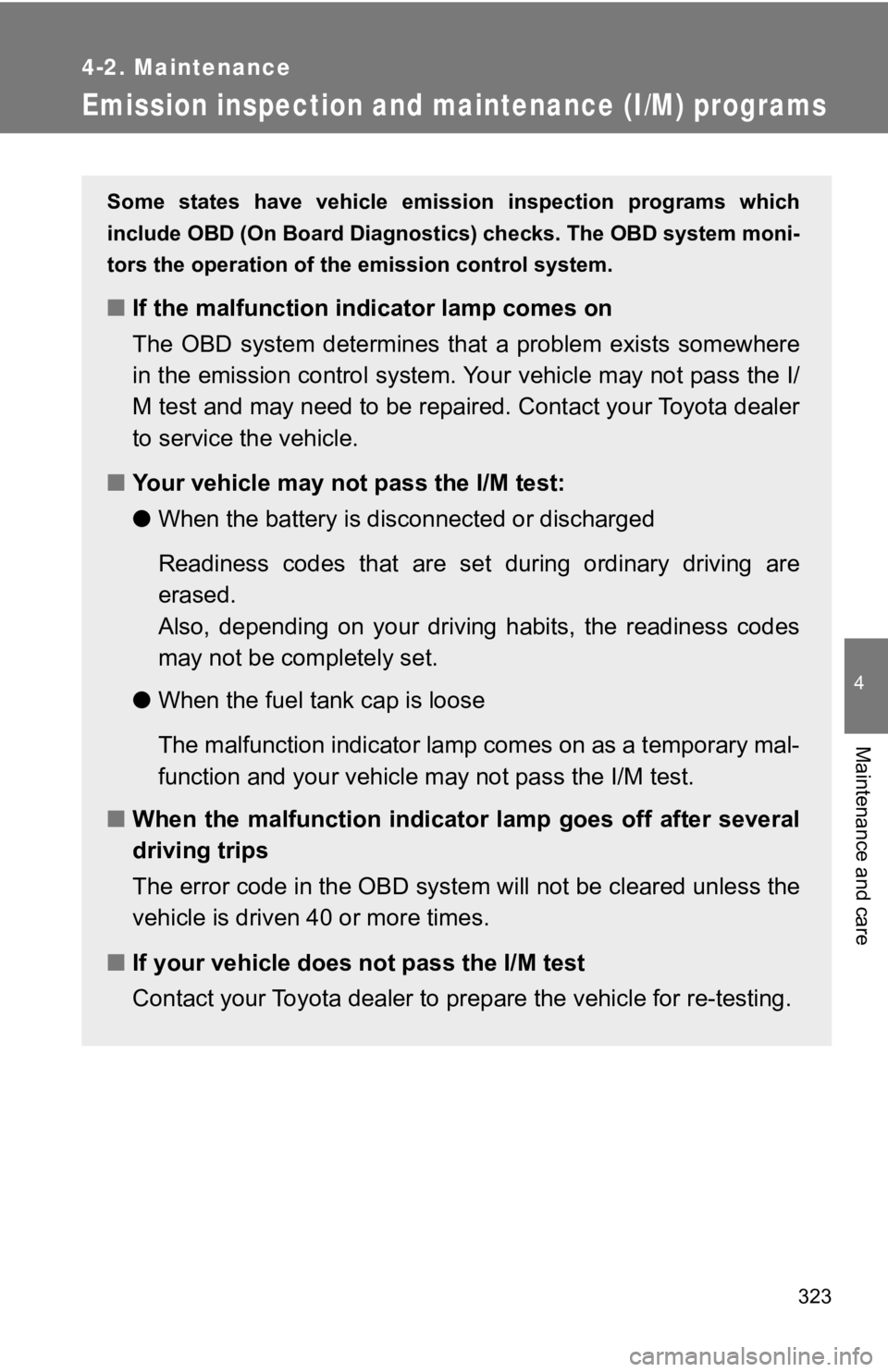Page 2 of 532

TABLE OF CONTENTS Index
21-1. Key information
Keys ..................................... 22
1-2. Opening, closing and
locking the doors and
trunk
Smart key system................. 25
Wireless remote control ....... 38
Doors.................................... 43
Trunk .................................... 46
1-3. Adjustable components
(seats, mirrors,
steering wheel)
Front seats ........................... 53
Rear seats ............................ 56
Head restraints ..................... 58
Seat belts ............................. 60
Steering wheel ..................... 67
Anti-glare inside rear
view mirror.......................... 68
Outside rear view mirrors ..... 69
1-4. Opening and closing
the windows
Power windows .................... 72
1-5. Refueling
Opening the fuel tank cap .... 75 1-6. Theft deterrent system
Engine immobilizer
system ................................ 79
Alarm .................................... 82
Theft prevention labels
(U.S.A.)............................... 86
1-7. Safety information
Correct driving posture ......... 87
SRS airbag
(Supplemental Restraint
System airbag) ................... 89
Front passenger occupant
classification system ......... 128
Child restraint systems ....... 137
Installing child restraints ..... 141
2-1. Driving procedures
Driving the vehicle .............. 152
Engine (ignition) switch
(vehicles with a smart
key system) ...................... 166
Engine (ignition) switch
(vehicles without a
smart key system) ............ 175
Automatic transmission ...... 178
Manual Transmission ......... 185
Turn signal lever ................. 188
Parking brake ..................... 189
Horn .................................... 1901
Before driving
2
When driving
Page 21 of 532

Before driving
1
211-1. Key information
Keys ................................... 22
1-2. Opening, closing and
locking the doors and
trunk
Smart key system .............. 25
Wireless remote control ..... 38
Doors ................................. 43
Trunk .................................. 46
1-3. Adjustable components
(seats, mirrors,
steering wheel)
Front seats ......................... 53
Rear seats.......................... 56
Head restraints................... 58
Seat belts ........................... 60
Steering wheel ................... 67
Anti-glare inside rear
view mirror ....................... 68
Outside rear view
mirrors.............................. 69 1-4. Opening and closing
the windows
Power windows .................. 72
1-5. Refueling
Opening the fuel
tank cap ........................... 75
1-6. Theft deterrent system
Engine immobilizer
system ............................. 79
Alarm.................................. 82
Theft prevention labels
(U.S.A.) ............................ 86
1-7. Safety information
Correct driving posture....... 87
SRS airbag
(Supplemental Restraint
System airbag)................. 89
Front passenger occupant
classification system ...... 128
Child restraint systems..... 137
Installing child restraints... 141
Page 75 of 532
75 1
Before driving 1-5. Refueling
Opening the fuel tank cap Perform the following steps to open the fuel tank cap:
■ Before refueling the vehicle
● Vehicles without a smart key system: Turn the engine switch
off and ensure that all the doo rs and windows are closed.
● Vehicles with a smart key system: Turn the “ENGINE START
STOP” switch off and ensure that all the doors and windows
are closed.
● Confirm the type of fuel. ( P. 7 6 )
■ Opening the fuel tank cap
Pull up the opener to open the
fuel filler door.
Turn the fuel tank cap slowly
to open.STEP 1
STEP 2
Page 76 of 532
761-5. Refueling
Closing the fuel tank cap
After refueling, turn the fuel tank
cap until you hear a click. Once
the cap is released, it will turn
slightly in the o pposite direction.Hang the fuel tank cap on the
back of the fuel filler door.STEP 3
■ Fuel types
Unleaded gasoline (octane rating of 93 [98 RON] or higher)
If unleaded gasoline with an octane rating of 93 (98 RON) is no t available,
unleaded gasoline with an octane rating of 91 (95 RON) may be u sed with
no detriment to engine durability or driveability.
Page 77 of 532

771-5. Refueling
1
Before driving WARNING■ Refueling the vehicle
Observe the following precautions while refueling the vehicle.
Failure to do so may result in death or serious injury.
● Do not handle fuel indoors.
● After exiting the vehicle and before opening the fuel door, tou ch an
unpainted metal surface to discharge any static electricity. It is important to
discharge static electricity before refueling because sparks re sulting from
static electricity can cause fuel vapors to ignite while refuel ing.
● Always hold the grips on the fuel tank cap and turn it slowly t o remove it.
A whooshing sound may be heard when the fuel tank cap is loosen ed.
Wait until the sound cannot be heard before fully removing the cap.
In hot weather, pressurized fuel may spray out of the filler ne ck and cause
injury.
● Do not allow anyone that has not discharged static electricity from their
body to come close to an open fuel tank.
● Do not allow anyone to approach the area of the vehicle near th e fuel filler
pipe while refueling is in progress.
● Do not inhale vaporized fuel.
Fuel contains substances that are harmful if inhaled.
● Do not smoke while refueling the vehicle.
Doing so may cause the fuel to ignite and cause a fire.
● Do not return to the vehicle or touch any person or object that is statically
charged.
This may cause static electricity to build up, resulting in a p ossible ignition
hazard.
Page 78 of 532

781-5. Refueling
WARNING■ When refueling
Observe the following precautions to prevent fuel overflowing f rom the fuel
tank:
● Securely insert the fuel nozzle into the fuel filler neck
● Stop filling the tank after the fuel nozzle automatically click s off
● Do not top off the fuel tank
● Observe other precautions that are posted at the service statio n.
● Turn the cap to the right until it clicks to ensure that it is fully tightened. If
the cap is not securely tightened, fuel spillage could occur in the event of
an accident, creating a fire hazard.
■ When replacing the fuel cap
Do not use anything but a genuine Toyota fuel tank cap designed for your
vehicle. Doing so may cause a fire or other incident which may result in
death or serious injury.
NOTICE■ Refueling
● Do not spill fuel during refueling.
Doing so may damage the vehicle, such as causing the emission c ontrol
system to operate abnormally or damaging fuel system components or the
vehicle's painted surface.
● Never add any cleaning agents to the fuel tank. The addition of a cleaning
agent may cause damage to the fuel system.
● Immediately put fuel in the tank whenever the low fuel warning light illumi-
nates. Engine misfires as a result of an empty tank could cause damage to
the engine.
Page 256 of 532

2562-5. Driving information
Cargo and luggage
Capacity and distribution
Cargo capacity depends on the to tal weight of the occupants.
(Cargo capacity) = (Tot al load capacity) - (Total weight of occ upants)
Steps for Determini ng Correct Load Limit
(1)Locate the statement “The co mbined weight of occupants and
cargo should never exceed XXX kg or XXX lbs.” on your vehicle's
placard.
(2)Determine the combined weight of the driver and passengers t hat
will be riding in your vehicle.
(3)Subtract the combined weight of the driver and passengers fr om
XXX kg or XXX lbs.
(4)The resulting figure equals the available amount of cargo and lug-
gage load capacity.
For example, if the “XXX” amount equals 1400 lbs. and there wil l
be five 150 lb passengers in your vehicle, the amount of availa ble
cargo and luggage load capacity is 650 lbs. (1400 - 750 (5 150) =
650 lbs.)
(5)Determine the combined wei ght of luggage and cargo being
loaded on the vehicle. That weight may not safely exceed the av ail-
able cargo and luggage load ca pacity calculated in Step 4.Take notice of the following information about storage precau-
tions, cargo capacity and load:
● Stow cargo and luggage in t he trunk whenever possible.
● Be sure all items are secured in place.
● To maintain vehicle balance while driving, position luggage
evenly within the luggage compartment.
● For better fuel economy, do no t carry unnecessary weight.
Page 323 of 532

3234-2. Maintenance
4
Maintenance and care
Emission inspection and maintenance (I/M) programs Some states have vehicle emissi on inspection programs which
include OBD (On Board Diagnosti cs) checks. The OBD system moni-
tors the operation of the emission control system.
■ If the malfunction i ndicator lamp comes on
The OBD system determines that a problem exists somewhere
in the emission control system. Y our vehicle may not pass the I /
M test and may need to be repaired. Contact your Toyota dealer
to service the vehicle.
■ Your vehicle may not pass the I/M test:
● When the battery is disconnected or discharged
Readiness codes that are set during ordinary driving are
erased.
Also, depending on your driving habits, the readiness codes
may not be completely set.
● When the fuel t ank cap is loose
The malfunction indicator lamp comes on as a temporary mal-
function and your vehicle m ay not pass the I/M test.
■ When the malfunction indicator lamp goes off after several
driving trips
The error code in the OBD system will not be cleared unless the
vehicle is driven 40 or more times.
■ If your vehicle does not pass the I/M test
Contact your Toyota dealer to pr epare the vehicle for re-testin g.